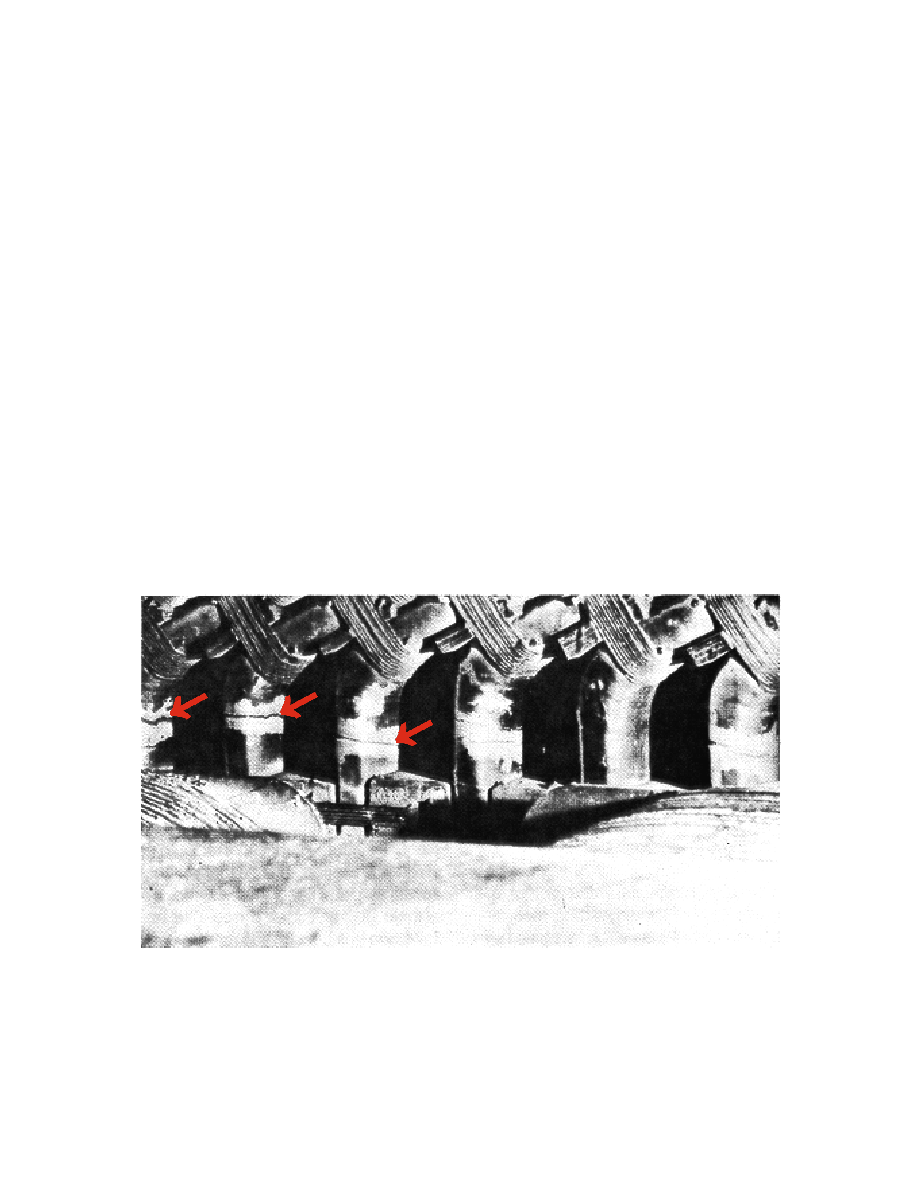

3. DAMAGE CAUSED BY EXPANSION OF
COPPER
COPPER
Temperature rise places stricter limits on loads
than consideration of total temperature alone,
Copper windings have a greater coefficient of
expansion than stator steel, and in addition, are
usually at a higher temperature. Under widely
fluctuating temperatures, portions of the coils
move in the steel slots with which they are in
contact and abrasion and cracking of insulation
may result. This movement is greater for machines
with long slots than short slots, and increases with
temperature rise. Since temperature rise varies
approximately as the square of the load, it can be
seen that a machine which must be overloaded
should have its load maintained as constant as
possible. This may be accomplished by holding
constant load on the overloaded machine as much
as possible, and carrying the fluctuating portion of
the system load on other machines which are not
overIoaded. The rate of load increase on cold
machines should be limited to not more than 10
percent of rated load per minute except in
emergencies when it is essential to pick up load
promptly. This restriction does not apply to
decreasing load, nor to varying load on a
than consideration of total temperature alone,
Copper windings have a greater coefficient of
expansion than stator steel, and in addition, are
usually at a higher temperature. Under widely
fluctuating temperatures, portions of the coils
move in the steel slots with which they are in
contact and abrasion and cracking of insulation
may result. This movement is greater for machines
with long slots than short slots, and increases with
temperature rise. Since temperature rise varies
approximately as the square of the load, it can be
seen that a machine which must be overloaded
should have its load maintained as constant as
possible. This may be accomplished by holding
constant load on the overloaded machine as much
as possible, and carrying the fluctuating portion of
the system load on other machines which are not
overIoaded. The rate of load increase on cold
machines should be limited to not more than 10
percent of rated load per minute except in
emergencies when it is essential to pick up load
promptly. This restriction does not apply to
decreasing load, nor to varying load on a
warmed-up generator. Hydroelectric generators
used for peaking power generation are sometimes
loaded at the gate opening speed when peaking
power is required on short notice. An example of
the damage (tape separation) done to asphalt-mica
insulated coils by excessive coil expansion and
contraction is shown in
used for peaking power generation are sometimes
loaded at the gate opening speed when peaking
power is required on short notice. An example of
the damage (tape separation) done to asphalt-mica
insulated coils by excessive coil expansion and
contraction is shown in
4. LIMITING TEMPERATURES FOR
INSULATION
INSULATION
The safe operating temperature of rotating
machine windings is limited by the heat which
insulating material will stand without abnormal
deterioration. This varies with different classes of
insulating materials as shown in
machine windings is limited by the heat which
insulating material will stand without abnormal
deterioration. This varies with different classes of
insulating materials as shown in
hottest spot temperatures shown in the table have
very little, if any, margin of safety for continuous
operation. The IEEE Standard No. 492 indicates
that life of class B insulation is halved with each 10
°C that the hottest spot temperature is above the
limiting temperatures given in
very little, if any, margin of safety for continuous
operation. The IEEE Standard No. 492 indicates
that life of class B insulation is halved with each 10
°C that the hottest spot temperature is above the
limiting temperatures given in
and a
number of manufacturers believe that 8°C is a
more realistic value. A curve ofinsulation life is
shown in
more realistic value. A curve ofinsulation life is
shown in
is based on an assumed life of 30 years when
operating continuously at the temperature shown.
operating continuously at the temperature shown.
Figure 1. - Example of stator end turn insulation cracking due to coil expansion and contraction.
Photo 3-5828
(FIST 1-4 3/91)
2